|
Lark and Gimpel-Pigeon Bronze
LARK Pigeon BRONZE as
a hereditary factor takes its name from the ocher-colored breast of
the Coburg larks, which was initially only considered appropriate
for the breed in the larked color-class. Only later did bars and
barless join them. That against resistance. Since the breed name
‘Lark’ was derived from the similarity in the wing shield with the
pattern of the songbird 'Lerche' (Lark).
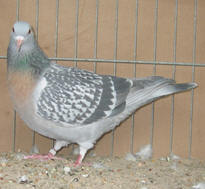
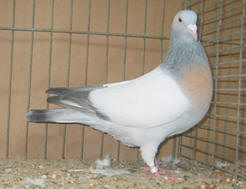
Fig. 1: Coburg larks larked and silver without bars (genetically
diluted lark bronze)
The ocher colored breast can also be found in other breeds. Strictly
speaking, the larks have the gene 'Lark Bronze' modified by the
dilution factor. Andreas Leiß had symbolized the gene after his
tests with Lb.
The undiluted form is revealed during crossings. Breeders and judges
usually don't see this at all and exhibit the pigeons as normal blue
birds and evaluate them that way, as shown here with the example of
the Montauban (Fig. 2). The hen has a diluted color with ocher
breast, the cock from the same loft with dark bronze breast color.
In the case of Thuringian Selfs, the breast is required as a
brown-red or, in the case of the diluted colored ones, as a yellow 'Noster'.
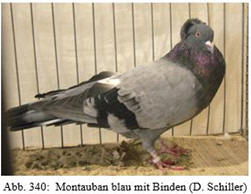
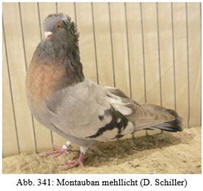
Fig. 2: Montauban: non-diluted Lark Bronze and diluted Lark Bronze
from the same loft. Source: Sell, Genetics of pigeon coloring
(German language), Achim 2015.
GIMPELPigeon
BRONZE: The term 'lark pigeon bronze' is some respect misleading.
Because with the 'Nuremberg Lark' there is another breed that goes
by the name 'Lark'. And this one has the also dominant Gimpel pigeon
bronze, not the Lark pigeon bronze. When diluted it also produces an
ocher color. Among the Nuremberg larks, these are the Larks and
‘Mehllichten’ (light like flour) with and without bars. Among Gimpel
pigeons, those diluted by 'pale' are called gold. The yellow color
of the Nuremberg Larks extends far beyond the chest compared to the
Coburg Larks. Up to the head, down to the lower abdomen. However,
not as far as well-bred golden Gimpel Pigeons (Fig. 3).
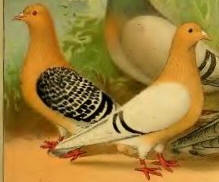
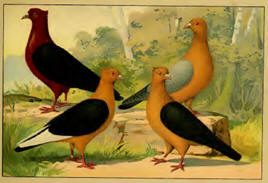
Fig. 3: Nuremberg larks larked and floured with bars (left). On the
right, Gimpel pigeons, copper-blackwings and variants of the golden
Gimpels. In the background on the left picture is a Coburg lark
(source: Schachzabel 1910).
When crossing Nuremberg larks with non-diluted partners, the
non-diluted Gimpel bronze is revealed in the copper breasted
offspring. This was the case in our own loft when mating a larked
cock with a blue-checkered hen. Due to sex-linkage and gender, the
young female standing next to it is diluted (Fig.4).
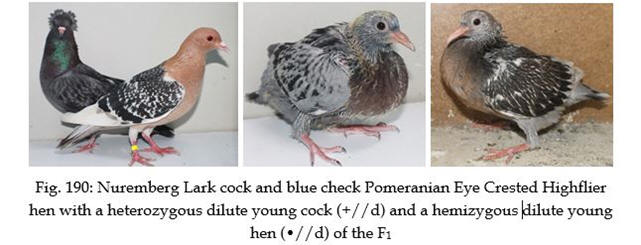
Fig. 4: Nuremberg lark pigeon (diluted Gimpel bronze) and blue-check
hen with heterozygous young for Gimpel pigeon bronze. Young cocks
from this sex-linked mating not diluted, young hens diluted. Source:
Sell, Pigeon Genetics, Achim 2012
DIFFERENCE IN YOUTH plumage:
The counterpart to the Lark Bronze without a dilution factor is
usually not perceived as a Lark Bronze by breeders or by judges at
shows (see above). The blue Montauban pictured, for example, was
exhibited and evaluated as a normal blue bar. When Gimpel pigeons
are crossed with other breeds, bronze, or diluted gold or ochre, in
many of the young can only be seen in the chest area, similar to
lark bronze. The position and extent of the bronze or ocher breast
are therefore not a sure distinguishing feature. One difference is
the moulting process. What is typical for lark bronze is that it
only develops during the moult. Shown using the example of a larked
hen in our own crosses with diluted Thuringian Selfs (Fig. 5).
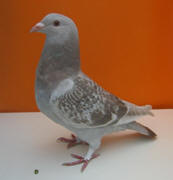
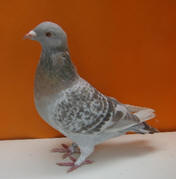
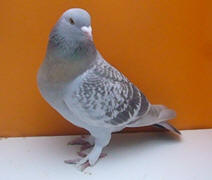
Fig. 5: Development of the ocher breast during the moult of Lark
Pigeon Bronze in an F1 hen from Thuringian Selfs
In contrast, Gimpel pigeon bronze and, in dilution, Gimpel pigeon
gold appear in juvenile plumage and usually extend beyond a spot on
the chest (Fig. 6).
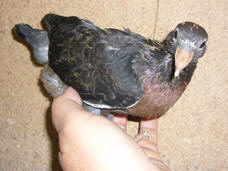
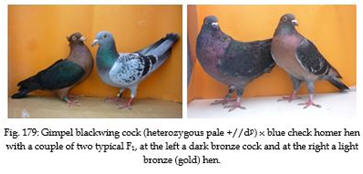
Fig. 6: Gimpel Pigeon Bronze show in crosses with other breeds still
in the juvenile plumage as bronze (or gold, when diluted). Own
crosses. Source: Sell, Pigeon Genetics 2012.
Sources:
Literatur:
Schachtzabel, Emil, Illustriertes Prachtwerk sämtlicher
Taubenrassen, Würzburg 1910
Sell, Pigeon Genetics.
Applied Genetics in the Domestic Pigeon, Achim 2012, https://www.taubensell.de
Sell, Genetik der Taubenfärbungen, Achim 2015
https://svcoburgerlerchen.de/geschichte-unserer-coburger-lerchen/ |